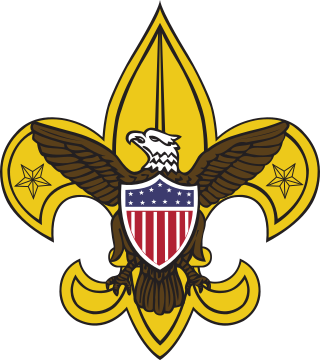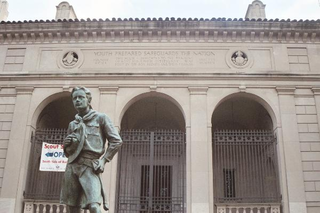Hiroshi Koshiba | |
|---|---|
| Born | November 9, 1884. |
| Died | June 19, 1925 (aged 40) Tokyo |
| Nationality | Japanese |
| Known for | One of the founders of the Japanese Scouting movement |
Koshiba Hiroshi (小柴 博, Tsuwano-chō, Shimane November 9, 1884 – June 19, 1925) was one of the founders of the Japanese Scouting movement.
He graduated from Tsuwano Elementary School. He entered Himeji Junior High School, a state school run by Hyogo Prefecture, but dropped out due to family reasons.
In 1903, he became a student at Shimane Normal School.
In 1905, he received a full Elementary School Teacher's licence, and became a teacher at Tsuwano Elementary School.
In 1907, he went to Tokyo, and worked at Akasaka Jinjo High School. Together with his colleagues, Hasunuma Monzō (蓮沼門三) and Iso Kikuma (磯規矩馬), he participated in the Shūyōdan (修養団) movement.
In 1909, he started the youth branch of the Shuyodan (修養団幼年会, Shūyōdan Yōnenkai). This group received support from, among others, Kurushima Takehiko (久留島武彦), Kishibe Fukuo (岸辺福雄) and Amano Kijihiko (天野雉彦), and held 61 meetings in six years, before being disbanded. It is reported that meetings consisted of events such as readings of children's stories and inspirational and improving stories, singing, excursions and group training, and were always extremely popular.
On October 7, 1913, Hasunuma Monzō and Uryū Kisaburō (瓜生喜三郎) had a discussion about youth education with Japan's ambassador to Russia Motono Ichirō (本野一郎), where Motono explained in detail about the Boy Scout principles and organization in Europe. They were greatly impressed, and told Koshiba how wonderful this organization was. Koshiba immediately set to work on forming a youth education group, founding the Tokyo Shōnengun (東京少年軍) ("Tokyo Youth Army"). This group's first excursion was to the temple known as Mejiro Fudōson (目黒不動尊) to visit the grave of Aoki Kon'yō (青木昆陽), and dig for imo potatoes.
In 1920, he participated in the First World Scout Jamboree in England, together with Shimoda Toyomatsu and Richard Suzuki.
On April 13, 1921, he reorganized the Shūyōdan Yōnenbu to form the Tokyo Shōnengun ("Tokyo Youth Army"). This was the first youth group based on the British Boy Scout training methods to be founded in Japan.
On June 19, 1925, he died in his Tokyo home of heart failure, aged 42.
Much of this article was translated from the equivalent article in the Japanese Wikipedia, as referenced on October 27, 2006.

Scouting, also known as the Scout Movement, is a worldwide youth social movement employing the Scout method. It is a program of informal education with an emphasis on practical outdoor activities, including camping, woodcraft, aquatics, hiking, backpacking, and sports. Another widely recognized movement characteristic is the Scout uniform, by intent hiding all differences of social standing in a country and encouraging equality, with neckerchief and campaign hat or comparable headwear. Distinctive uniform insignia include the fleur-de-lis and the trefoil, as well as merit badges and other patches.

A Scout is a child, usually 10–18 years of age, participating in the worldwide Scouting movement. Because of the large age and development span, many Scouting associations have split this age group into a junior and a senior section. Scouts are organized into troops averaging 20–30 Scouts under the guidance of one or more Scout Leaders or Scoutmasters. Troops subdivide into patrols of about 6–8 Scouts and engage in outdoor and special interest activities. Troops may affiliate with local, national, and international organizations. Some national Scouting associations have special interest programs such as Air Scouts, Sea Scouts, outdoor high adventure, Scouting bands, and rider Scouts. In the United States there were around 6 million scouts in 2011.

Baron Wakatsuki Reijirō was a Japanese politician and Prime Minister of Japan.

Shimane Prefecture is a prefecture of Japan located in the Chūgoku region of Honshu. Shimane Prefecture is the second-least populous prefecture of Japan at 665,205 and has a geographic area of 6,708.26 km2. Shimane Prefecture borders Yamaguchi Prefecture to the southwest, Hiroshima Prefecture to the south, and Tottori Prefecture to the east.

Founded in 1908, The Scout Association of Malta (TSAM) is the Scouting organization in Malta. TSAM has always maintained a high and respectable Scouting tradition. Its leaders and members are committed to further the ideals of Scouting in line with those as traditionally established by the youth movement's Founder, Lord Robert Baden-Powell of Gilwell, and as further developed by the World Organization of the Scout Movement (WOSM). TSAM is a forward looking youth movement which, as a non-governmental organisation (NGO), enjoys great respect both locally and internationally. It is the only association in Malta which is recognised by the WOSM, and is also a member of the European Scout Region.

Outdoor education is organized learning that takes place in the outdoors, such as during school camping trips. Outdoor education programs sometimes involve residential or journey wilderness-based experiences which engage participants in a variety of adventurous challenges and outdoor activities such as hiking, climbing, canoeing, ropes courses and group games. Outdoor education draws upon the philosophy, theory, and practices of experiential education and environmental education.

Scout Association of Croatia is the Croatian national Scouting organization. As part of Yugoslavia, Croatia was a founding member of the World Organization of the Scout Movement from 1922 to 1948. Independently, Croatia has been a member of the World Organization since 1993, and joined the World Association of Girl Guides and Girl Scouts in 2023, making it a "Scout & Guide National Organization". The coeducational Savez Izviđača Hrvatske has 3,827 members as of 2011.

The Scout Association of Japan is the major Scouting organization of Japan. Starting with boys only, the organization was known as Boy Scouts of Japan from 1922 to 1971, and as Boy Scouts of Nippon from 1971 to 1995, when it became coeducational in all sections, leading to neutral naming. Scouting activity decreased radically during World War II but slowly recovered; membership at the end of May 2017 was 99,779.

The Myanmar Scout Association is the national Scouting organization in Myanmar. Scouting in Myanmar was started in 1916 and disbanded in 1964 due to country's political changes; the current organization was formed in 2012 under the supervision and support of the Ministry of Education of Myanmar and became a member of the World Organization of the Scout Movement on 11 August 2016. It has about 21,007 members.

Iran Scout Organization was founded in 1925 under the rule of Reza Shah Pahlavi. Currently Iran is one of 29 countries where Scouting exists but where there is no National Scout Organization which is a member of the World Organization of the Scout Movement at the present time.
Lone Scouts are members of the Scout movement who undertake scout activities on their own or by distance communication, usually because they live in isolated areas or otherwise do not participate in scout activities with other scouts. A Lone Scout may have an adult Scout leader or counselor who may instruct and supervise them. They can follow the same program as other Scouts and may advance in the same way as all other Scouts.

Scouts BSA is the flagship program and membership level of the Boy Scouts of America (BSA) for coeducational young people between the ages of typically 11 and 17. It provides youth training in character, citizenship, personal fitness, and leadership, and aims to develop the skills necessary to become successful adults.

Scouting in the United States is dominated by the 1.2 million-member Boy Scouts of America and the Girl Scouts of the USA and other associations that are recognized by one of the international Scouting organizations. There are also a few smaller, independent groups that are considered to be "Scout-like" or otherwise Scouting related.
Toyomatsu Shimoda, born in Iwanai District, Hokkaidō, helped to establish what became the Scout Association of Japan. He was Japan's first Chief Scout.
Non-aligned Scouting organizations is a term used by the World Organization of the Scout Movement (WOSM), World Association of Girl Guides and Girl Scouts (WAGGGS) and their member national organizations to refer to Scouting organizations that are not affiliated with them. See List of non-aligned Scouting organizations.

Viscount Michiharu Mishima was a novelist, playwright and drama critic. His pen name was Shōdō Mishima.

Sand Chronicles is a Japanese manga series written and illustrated by Hinako Ashihara. It was serialized in Shogakukan's Betsucomi magazine from the May 2003 issue to the July 2006 issue. Shogakukan collected the individual chapters into 10 bound volumes from August 2003 to August 2006. The series won the 50th Shogakukan Manga Award in the shōjo category in 2005.
Mitsumasa Anno was a Japanese illustrator and writer of children's books, known best for picture books with few or no words. He received the international Hans Christian Andersen Medal in 1984 for his "lasting contribution to children's literature."

Tsuwano Castle was a Japanese castle located in what is now the city of Tsuwano, Shimane Prefecture, in the San'in region of far western Japan. Its ruins have been protected by the central government as a National Historic Site since 1942. In its early history, it was called Sanbonmatsu Castle or Ipponmatsu Castle. During the Edo Period, it was the center of Tsuwano Domain ruled by the Kamei clan; however, the administrative offices and daimyō residence were located at the base of the mountain to avoid the steep mountain paths.

Shō Fukao was a Japanese socialist and educator. He was a pioneer in Japanese socialism and in the early Boy Scout movement in Japan.